April 13th, 2015—Twins
Two more Royals get hit by pitches and one of them is Alex Rios. Minnesota Twins rookie J.R. Graham loses control of a fastball and clips Rios on the hand. A bone is broken and Rios is out for a while. Afterwards Rios questions whether Graham is ready for the Big Leagues.
To pitch in the Big Leagues everybody know you have to pitch inside; if you don’t, hitters are going to lean out and make the outer third of the plate the middle of the plate. You pitch inside to keep the hitters honest, but you need enough control to pitch inside and not hit anybody.
The Royals have had 12 batters hit by pitches and the Royals pitchers have only hit two batters on other teams.
Whether it’s intentional or not—and in Rios’ case it looks like an accident—too many Kansas City hitters are getting drilled and the Kansas City pitchers need to protect their hitters by drilling someone on the other teams.
That might seem brutal or childish or the kind of thing that would get you sent to anger-management classes, but like it or not, it’s the way things work in the Big Leagues.
If the Royals pitchers don’t respond it will send a bad message to the rest of the league: you can pitch inside and hit our batters and we won’t retaliate.
And if a team’s pitchers won’t protect their teammates, it can hurt team unity.
But some pitchers don’t want to throw at a batter. Sometimes it’s because the pitcher doesn’t want to unintentionally hurt someone, sometimes it’s because the pitcher doesn’t want the hitter charging the mound and sometimes it’s just plain selfishness: the pitcher doesn’t want to hurt his numbers by putting runners on base.
Nevertheless, the Royals pitchers need to respond or it will send a message to the other teams—and their teammates.
Rusty Kuntz—2015
In 2015 the Royals are on a team flight and Assistant General Manager J.J. Picollo has his wife Nicole along. She spots Rusty Kuntz looking at his laptop and asks J.J. what Rusty’s up to and J.J. tells her to keep watching:
Rusty’s winning them a baseball game.
40 minutes later Rusty is still looking at his laptop: he’s watching two deliveries by the same pitcher. One delivery is a pitch thrown to home plate; the other delivery is an attempted pickoff at first base. Rusty’s watching each delivery frame-by-frame and taking notes.
Rusty’s looking for a key: something the Royals base runners can look for that will indicate what the pitcher is about to do. One guy might drop his glove when he’s about to attempt a pickoff. Another guy might exhale when he’s about to throw home—these are the kind of things Rusty searches for.
Pitcher delivery times are normally measured from the time they lift their front foot to the time the ball hits the catcher’s mitt. Let’s say that once a pitcher lifts his front foot, he delivers the ball to home plate in 1.3 seconds; that’s too fast for most of the Royals to steal on.
But if Rusty can find a key—some unconscious tick, some movement, some mannerism that gives the pitcher’s intentions away earlier than the front foot lifting—that 1.3 second delivery can become 1.5 seconds. Now the Royals can run on that pitcher.
So just how big a deal is two-tenths of a second?
If the runners can break for second base two-tenths of a second earlier, they’ll be a little over four feet closer to the bag when the catcher receives the ball. Two-tenths of a second head start is the difference between being thrown out easily and sliding in safely with room to spare.
OK, so now you’re a pitcher who wants to stop the Royals from stealing second base; you might decide to use a slide step.
A slide step is just what it sounds like: the pitcher doesn’t lift his front foot as high—he barely picks it up and slides it toward home plate. Because the pitcher doesn’t lift his front foot as high, it takes less time to get his foot back on the ground and deliver the pitch; everything happens more quickly.
But when a pitcher slide steps, his bottom half is moving faster than normal and it’s not uncommon for the throwing arm to never catch up. That means the pitcher’s arm is late, his release point’s too high and that makes the pitch stay up in the strike zone. The slide step can also take a few miles an hour off a pitcher’s fastball.
Once you start looking for it, you see a lot of big hits given up out of the slide step.
In 2015 the Royals are second in the league in stolen bases and tied for second in batting average—the Royals believe the two numbers are related.
April 17th, 2015—Athletics
It’s a weird play: Brett Lawrie is on first base when Josh Reddick hits the ball back to the mound. The ball glances off pitcher Kelvin Herrera’s heel, it’s then picked up by third baseman Mike Moustakas and shoveled to Alcides Escobar—Esky’s covering second base.
Escobar is stretched out like a first baseman to take the toss from Moustakas. Lawrie slides late, aims at Escobar and slams into Escobar’s left knee. The takeout slide looks unnecessary because Escobar is clearly making no attempt to turn two; there is no double play to break up.
Brett Lawrie, his manager Bob Melvin and anybody else the A’s can get to spout the party line say it was a routine takeout slide of a pivot man trying to turn two.
The Royals don’t buy it.
The Royals are already unhappy with the number of batters they’ve had hit and now this: some of the Kansas City players feel like they being challenged by the rest of the league to see how they’ll respond.
Their response comes the next day.
April 18th, 2015—Athletics
The Royals are losing 5-0 to the Athletics when Brett Lawrie comes to the plate in the fourth inning. Winning a game is usually considered more important than retaliating, but if you’re already losing by five runs, what the hell, it’s not a bad time to take care of unfinished business.
Yordano Ventura smokes Lawrie on the elbow with a 99-MPH fastball.
The benches clear, but everybody knew it was coming and nobody actually wants to fight. Ventura is ejected from the game without a warning being issued first.
But the point is made: later in the game when Lawrie gets a chance to flip Royals shortstop Christian Colon, Lawrie slides early and straight into the bag—two things he didn’t do when he hurt Alcides Escobar.
Lawrie screwed up, got punished for it, learned his lesson and harmony was restored to the Universe and the Game of Baseball.
For about 24 hours.
April 19th, 2015—Athletics
The next morning the consensus opinion in the Royals clubhouse is that order has been restored and things can go back to normal. Lawrie has been punished for his dirty slide and the feud’s over; Lorenzo Cain says there’s a clean slate for everyone.
But once the game starts, A’s pitcher Scott Kazmir hits Cain with a 92-MPH two-seam fastball; Kazmir gets a warning, but is not ejected.
Which pisses off the players and coaches on the Kansas City bench. The day before Ventura had been ejected without a warning and the Royals are unhappy that Kazmir is still on the field.
If Ventura was ejected without a warning, why isn’t Kazmir?
The Royals are barking from the bench and home plate umpire Greg Gibson ejects pitching coach Dave Eiland. Apparently Eiland is yelling at Kazmir and the umpires think Eiland’s yelling at them.
Then Gibson warns manager Ned Yost not to come out on the field. Ned does anyway and gets ejected—and the umpires are just warming up.
Kelvin Herrera is pitching the eighth inning and decides it’s time to get in on the act—he throws a 100-MPH fastball behind Lawrie. One replay makes the pitch look up around the shoulders; another replay makes it look even higher. Wherever the fastball is located, Lawrie isn’t happy and neither are the umpires.
Herrera is ejected and as he leaves the field, he looks back at Lawrie and points to his own head.
There’s a line pitchers are not supposed to cross and it’s located at the shoulders. If you hit a batter below the shoulders it hurts, but if it’s done correctly it won’t cause serious injury. Throw above the shoulders and you’re talking about major damage.
Herrera says he pointed at his own head to tell Lawrie to: “Think about it.”
Lawrie says he interpreted the gesture to mean: “Next time I’m gonna hit you in the head."
According to the unwritten rules of the game, most of the stuff the Royals have done in response is justifiable; threatening to hit a player in the head isn’t.
When Ned was ejected, bench coach Don Wakamatsu became acting manager. When Kelvin Herrera is ejected after a warning, the manager’s ejection is automatic. Wakamatsu—already automatically ejected—comes out to argue and gets ejected again, which is a new one on everybody. The umpires have tossed so many people they lose track.
It’s a wild scene.
After the game Royals players talk about whether Kazmir hit Cain intentionally, but some players feel it doesn’t matter if it was intentional or not; too many Kansas City players are getting hit with pitches and the Royals are going to let the rest of the league know that if one of their guys gets drilled, there will be repercussions.
Danny Duffy says: “I’m tired of my brothers with bruises.”
The pitchers are protecting the hitters; the Kansas City Royals are pulling together and drawing a line in the sand.
It’s hard to defend Kelvin Herrera retaliating by throwing behind Lawrie and then pointing at his head, but if Lawrie really wanted to do something about it, he had his opportunity.
When I was working on the book “Throwback” with Jason Kendall he wasn’t shy about expressing his opinions. Kendall believed that if a hitter had a problem with what a pitcher did, the hitter could go to the mound and do something about it. And if the hitter didn’t want to go to the mound, he should shut the fuck up and take his base.
In Kendall’s mind an annoying number or people—or maybe that’s a number of annoying people—choose a third alternative: they stand at home plate, huff and puff, point fingers and wait for their teammates to come out of the dugout and hold them back.
When I ask him what he thought of Lawrie’s reaction to Herrera’s pitch, Kendall says:
“He had his chance and he let Greg Gibson hold him back.”
Lawrie is six feet tall and weighs 210 pounds; if he really wanted to go after Herrera, a middle-aged umpire putting a hand out wouldn’t stop him.
After the series is over Lawrie complains that the Royals play a dirty brand of baseball.
Alex Rios says the Athletics are just playing naïve; Lawrie was the one who started things when he hurt Escobar. Then, after Lawrie receives his punishment, Kazmir starts things up again when he hits Cain.
The A’s start something, then act hurt and innocent when the Royals respond.
Message Received Loud and Clear
Whatever fans or umpires or opposing teams think about it, the Royals pitchers responding seems to have an effect: in April the Royals had 20 batters hit, in May it’s 9 and in June it’s 7.
Things heat back up in July, but we’ve got one more brawl to talk about first.
Next up: The Rowdy Royals get in yet another fight.


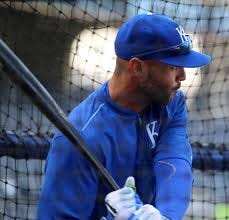
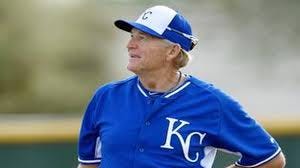
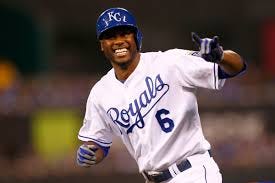
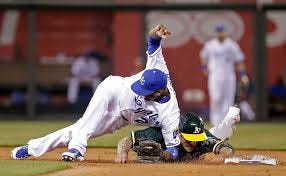


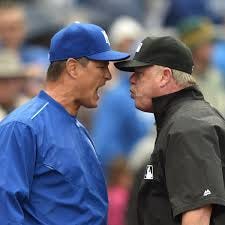
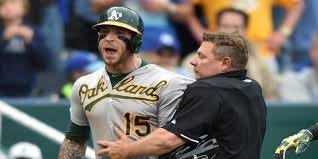
Recall a game against Cleveland when Willie Wilson gets drilled early, perhaps leading off the game.
Danny Jackson drilled either the first or second Cleveland batter and is immediately ejected.
As Jackson walked toward the dugout, Willie was on the top step, extending his hand for a "thank you" shake.